The role of technology in diabetes management has become increasingly important in recent years. With advances in medical technology, people with diabetes are now able to better manage their condition and achieve better health outcomes. In this article, we will discuss the role of technology in diabetes management, including insulin pumps and continuous glucose monitoring devices.
Diabetes is a chronic condition that affects millions of people around the world. It occurs when the body is unable to produce or properly use insulin, a hormone that regulates blood sugar levels. As a result, people with diabetes must closely monitor their blood sugar levels and take measures to keep them within a target range. In the past, this often involved frequent finger sticks, injections, and daily monitoring of food intake, exercise, and other lifestyle factors.
But in recent years, technology has dramatically changed the landscape of diabetes management. Now, people with diabetes have access to a range of devices and technologies that make it easier to monitor their blood sugar levels, deliver insulin, and manage their condition. Two of the most important technologies in this regard are insulin pumps and continuous glucose monitoring (CGM) devices.
Insulin pumps are small, wearable devices that deliver insulin continuously throughout the day, mimicking the way that the pancreas delivers insulin in people without diabetes. Insulin pumps can be programmed to deliver different amounts of insulin based on a person’s activity level, food intake, and other factors. This helps people with diabetes better manage their blood sugar levels and avoid dangerous highs and lows.
Continuous glucose monitoring devices are small sensors that are worn under the skin and measure glucose levels in interstitial fluid. They provide a real-time view of glucose levels and allow people with diabetes to make more informed decisions about food, exercise, and insulin doses. Some continuous glucose monitoring devices even have alarms that can alert the person when their blood sugar levels are trending too high or too low, allowing them to take action before the situation becomes dangerous.
Together, insulin pumps and continuous glucose monitoring devices offer a powerful toolkit for people with diabetes to better manage their condition. By providing real-time information about glucose levels, these devices help people with diabetes make more informed decisions about their health and lifestyle. They also make it easier to avoid dangerous highs and lows, and to maintain better overall glycemic control.
One of the key benefits of insulin pumps and continuous glucose monitoring devices is that they allow people with diabetes to be more proactive about managing their condition. In the past, people with diabetes had to rely on finger sticks and other forms of glucose testing to understand their blood sugar levels. But with continuous glucose monitoring, people with diabetes can see their glucose levels in real-time and make adjustments to their insulin doses and other habits as needed. This helps people with diabetes avoid dangerous spikes and dips, and maintain better overall glycemic control.
Another benefit of insulin pumps and continuous glucose monitoring devices is that they make it easier for people with diabetes to maintain a healthy lifestyle. With real-time information about glucose levels, people with diabetes can more effectively plan meals and snacks, exercise, and make other lifestyle changes that support their health. This can help reduce the risk of complications related to high or low blood sugar levels, and improve overall health outcomes.
Insulin pumps and continuous glucose monitoring devices also have the potential to improve mental health outcomes for people with diabetes. Managing diabetes can be a stressful and demanding task, and it can be difficult for people with diabetes to maintain a positive outlook and good emotional well-being. With the help of technology, however, people with diabetes can better manage their condition, reduce stress and anxiety, and maintain a higher quality of life.
Finally, insulin pumps and continuous glucose monitoring devices can help people with diabetes achieve better health outcomes and reduce the risk
of diabetes-related complications. By providing real-time information about glucose levels and helping people with diabetes make more informed decisions about their health and lifestyle, these technologies can help people with diabetes maintain better overall glycemic control. This, in turn, can reduce the risk of long-term complications such as cardiovascular disease, nerve damage, and eye and kidney damage.
In conclusion, the role of technology in diabetes management is an increasingly important aspect of healthcare. Insulin pumps and continuous glucose monitoring devices offer a powerful toolkit for people with diabetes to better manage their condition and achieve better health outcomes. With these technologies, people with diabetes can be more proactive, maintain a healthy lifestyle, reduce stress and anxiety, and reduce the risk of long-term complications. As technology continues to advance, it is likely that we will see even more tools and devices become available to help people with diabetes manage their condition and live healthier, happier lives.
